National Museum of Women of Modern Arts Washington Dc
 Chief facade | |
 | |
| Established | 1910 (1910) |
|---|---|
| Location | National Mall in Washington, D.C., United states |
| Coordinates | 38°53′29″N 77°01′33″W / 38.8913°N 77.0259°West / 38.8913; -77.0259 Coordinates: 38°53′29″N 77°01′33″Westward / 38.8913°Due north 77.0259°W / 38.8913; -77.0259 |
| Type | Natural History |
| Visitors | 572,638 (2020)[ane] |
| Manager | Kirk Johnson |
| Public transit access | |
| Website | naturalhistory |
The National Museum of Natural History is a natural history museum administered past the Smithsonian Institution, located on the National Mall in Washington, D.C., U.s.a.. It has gratis admission and is open 364 days a yr. In 2016, with 7.one million visitors, information technology was the eleventh nearly visited museum in the globe and the most visited natural history museum in the world.[2] Opened in 1910, the museum on the National Mall was i of the kickoff Smithsonian buildings constructed exclusively to hold the national collections and enquiry facilities.[3] The principal building has an overall surface area of i.5 meg square feet (140,000 m2) with 325,000 square feet (30,200 one thousandii) of exhibition and public space and houses over 1,000 employees.[3]
The museum's collections contain over 145 million specimens[4] of plants, animals, fossils, minerals, rocks, meteorites, human remains, and human cultural artifacts, the largest natural history collection in the world.[5] It is also dwelling house to well-nigh 185 professional natural history scientists—the largest group of scientists dedicated to the study of natural and cultural history in the world.
History [edit]
1846–1911 [edit]
The U.s.a. National Museum was founded in 1846 as part of the Smithsonian Institution. The museum was initially housed in the Smithsonian Institution Building, which is better known today as the Smithsonian Castle. A formal exhibit hall opened in 1858.[6] The growing collection led to the construction of a new edifice, the National Museum Building (known today as the Arts and Industries Building). Covering a and then-enormous ii.25 acres (nine,100 m2), it was built in merely 15 months at a toll of $310,000. Information technology opened in March 1881.[7]
Congress authorized construction of a new building on June 28, 1902.[8] [ix] On January 29, 1903, a special committee equanimous of members of Congress and representatives from the Smithsonian's board of regents published a report request Congress to fund a much larger structure than originally planned.[9] The regents began considering sites for the new edifice in March, and by April 12 settled on a site on the northward side of B Street NW between 9th and 12th Streets.[x] [11] The D.C. architectural firm of Hornblower & Marshall was chosen to blueprint the structure.[11] Testing of the soil for the foundations was set for July 1903, with construction expected to take iii years.[12]
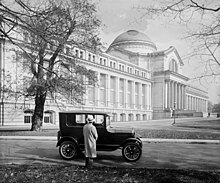
The Natural History Building (as the National Museum of Natural History was originally known) opened its doors to the public on March 17, 1910, in order to provide the Smithsonian Institution with more than space for collections and research.[13] The building was not fully completed until June 1911.[14] The structure cost $iii.v million (nearly $85 one thousand thousand in inflation-adjusted 2012) dollars.[fifteen] The Neoclassical mode building was the first structure synthetic on the northward side of the National Mall as part of the 1901 McMillan Committee program. In addition to the Smithsonian's natural history collection, information technology also housed the American history, art, and cultural collections.
1981–2003 [edit]
Between 1981 and 2003, the National Museum of Natural History had xi permanent and acting directors.[16] There were six directors solitary between 1990 and 2002. Turnover was high every bit the museum's directors were disenchanted by low levels of funding and the Smithsonian'due south disability to clearly define the museum's mission. Robert Due west. Fri was named the museum's manager in 1996.[17] One of the largest donations in Smithsonian history was fabricated during Fri's tenure. Kenneth Eastward. Behring donated $twenty one thousand thousand in 1997 to modernize the museum. Fri resigned in 2001 afterwards disagreeing with Smithsonian leadership over the reorganization of the museum'southward scientific enquiry programs.[18]
J. Dennis O'Connor, Provost of the Smithsonian Institution (where he oversaw all science and research programs) was named interim director of the museum on July 25, 2001.[xix] Eight months afterward, O'Conner resigned to get the vice president of research and dean of the graduate schoolhouse at the University of Maryland.[twenty] Douglas Erwin, a paleontologist at the National Museum of Natural History, was appointed interim director in June 2002.[21]

2003–2007 [edit]
In Jan 2003, the Smithsonian announced that Cristián Samper, a Colombian[xviii] with an Thou.Sc. and Ph.D. from Harvard University, would get the museum'southward permanent director on March 31, 2003.[22] Samper (who holds dual citizenship with Colombia and the United States)[22] founded the Alexander von Humboldt Biological Resources Enquiry Institute and ran the Smithsonian Tropical Research Institute after 2001. Smithsonian officials said Samper'due south authoritative feel proved critical in his date.[16] Under Samper's direction, the museum opened the $100 one thousand thousand Behring Hall of Mammals in Nov 2003,[23] received $lx one thousand thousand in 2004 for the Sant Hall of Oceans,[24] and received a $one million gift from Tiffany & Co. for the buy of precious gems for the National Gem Collection.[25]

On March 25, 2007, Lawrence M. Small, Secretary of the Smithsonian Institution and the system'south highest-ranking appointed official, resigned abruptly after public reports of lavish spending.[26]
2007–2012 [edit]
On March 27, 2007, Samper was appointed Acting Secretary of the Smithsonian.[27] Paul Grand. Risser, former chancellor of the University of Oklahoma, was named interim director of the Museum of Natural History on March 29.[28]
Samper's tenure at the museum was not without controversy. In May 2007, Robert Sullivan, the one-time acquaintance director in charge of exhibitions at the National Museum of Natural History, charged that Samper and Smithsonian Undersecretary for Science David Evans (Samper's supervisor) ordered "last minute"[29] changes in the exhibit "Arctic: A Friend Acting Strangely" to tone down the office of human beings in the discussion of global warming, and to brand global warming seem more uncertain than originally depicted. Samper denied that he knew of whatever scientific objections to the changes, and said that no political pressure level had been practical to the Smithsonian to make the changes.[xxx] In November 2007, The Washington Post reported that an interagency group of scientists from the Department of the Interior, NASA, National Oceanic and Atmospheric Administration (NOAA), and National Science Foundation believed that, despite Samper's denial, the museum "acted to avoid criticism from congressional appropriators and global-warming skeptics in the Bush administration".[29] The changes were discussed as early as mid-Baronial 2005, and Dr. Waleed Abdalati, director of NASA'southward Cryospheric Sciences Program, noted at the time that "At that place was some give-and-take of the political sensitivities of the exhibit."[29] Although the showroom was due to open in October 2005, the Post reported that Samper ordered a six-month delay to let for fifty-fifty farther changes. The newspaper besides reported that it had obtained a memo drafted by Samper shortly after Oct 15, 2005, in which Samper said the museum should non "replicate" work past the Intergovernmental Console on Climate change. A few weeks later, a NOAA climate researcher advised a superior that the delay was due to "the argue inside the administration and the scientific discipline customs over the existence and cause of global warming".[29] During the delay, Samper asked high-level officials in other government agencies and departments to review the script for the exhibit, ordered his museum staff to make additionals changes, and rearranged the sequence of the showroom panels so that the discussion of climate change was non immediately encountered past museum visitors.[29] Before long earlier the exhibit opened in April 2006, officials at NOAA and the United states Department of Commerce expressed to their superiors their opinion that the exhibit had been changed to accommodate political concerns.[29] In an interview with The Washington Post in November 2007, Samper said he felt the exhibit displayed a scientific certainty that did not exist, and expressed his belief that the museum should present evidence on both sides and permit the public brand upward its ain mind.[29]

The controversy became more heated afterward the printing reported that Samper gave permission for the museum to have a $five 1000000 donation from American Petroleum Constitute that would support the museum's soon-to-be-opened Hall of Oceans. Two members of the Smithsonian Institution'southward Board of Regents (which had terminal say on accepting the donation) questioned whether the donation was a conflict of involvement.[29] Before the board could consider the donation, the donor withdrew the offer.[31]
Risser resigned as acting managing director of the museum on January 22, 2008, in order to return to his position at the University of Oklahoma.[32] No new acting director was named at that time. 6 weeks subsequently, the Smithsonian regents chose Georgia Tech president G. Wayne Clough every bit the new Secretary. Samper stepped down to return to his position as Director of the National Museum of Natural History.[33]
The residual of Samper's tenure at the museum proved less controversial. In June 2008, the Victoria and Roger Sant family unit donated $15 1000000 to endow the new Ocean Hall at the museum.[34] The museum celebrated the 50th anniversary of its conquering of the Hope Diamond in August 2009 by giving the gemstone its ain exhibit and a new setting.[35] In March 2010, the museum opened its $21 one thousand thousand human evolution hall.[36]
In January 2012, Samper said he was stepping down from the National Museum of Natural History to get president and chief executive officer of the Wild fauna Conservation Club.[37] Two months later, the museum announced it had received a $35 million gift to renovate its dinosaur hall,[38] and a month afterward the Sant family unit donated another $10 million to endow the director'due south position.[39] On July 25, 2012, Kirk Johnson, vice president of research and collections at the Denver Museum of Nature and Scientific discipline, was named Samper'south successor effective Oct 29, 2012.[40] Johnson oversees a museum with 460 employees and a $68 million budget.[41]
Enquiry and collections [edit]
The NMNH represents 90% of the Smithsonian Institution's collections and forms one of the largest, most comprehensive natural history collection in the world.[42] The Smithsonian gives an approximate number for artifacts and specimens of 146 one thousand thousand.[43] More specifically, the collections include 30 million insects, four.five 1000000 plants preserved in the Museum's herbarium, and 7 one thousand thousand fish stored in liquid-filled jars.[44] The National Collection of Amphibians and Reptiles has more than tripled from 190,000 specimen records 1970 to over 580,000 specimen records in 2020.[45] [46] Of the 2 million cultural artifacts, 400,000 are photographs housed in the National Anthropological Athenaeum.[44] Through off-site active loan and exchange programs, the museum's collections can be accessed.[47] Equally a result, 3.5 million specimens are out on loan every twelvemonth.[44] The rest of the collections not on display are stored in the non-public research areas of the museum and at the Museum Support Centre, located in Suitland, Maryland.[48] Other facilities include a marine science middle in Ft. Pierce, Florida and field stations in Belize, Alaska, and Kenya.[44]
Research in the museum is divided into 7 departments: anthropology, botany, entomology, invertebrate zoology, mineral sciences, paleobiology, vertebrate zoology.[3]
One collection of nearly a million specimens of birds, reptiles, and mammals kept at the museum has been maintained by the Biological Survey unit of the U.S. Geological Survey. This division had started in 1885 equally an economic ornithology unit of the Agriculture Department. Clarence Birdseye and Clinton Hart Merriam had worked in this organisation. As of February 2018, the unit's funding is planned to be cutting, and it is not clear what would happen to the collection.[49]
Exhibitions [edit]
Hall of Geology, Gems, and Minerals [edit]


The National Gem and Mineral Collection is one of the nigh meaning collections of its kind in the globe. The collection includes some of the most famous pieces of gems and minerals including the Hope Diamond and the Star of Asia Sapphire, one of the largest sapphires in the world. At that place are currently over 15,000 individual gems in the drove, besides every bit 350,000 minerals and 300,000 samples of rock and ore specimens.[50] Additionally, the Smithsonian's National Jewel and Mineral Drove houses approximately 45,000 meteorite specimens, including examples of every known blazon of meteorite,[51] and is considered to exist one of the most comprehensive collections of its kind in the globe.[50]
The collection is displayed in the Janet Annenberg Hooker Hall of Geology, Gems and Minerals, i of the many galleries in the Museum of Natural History. Some of the most important donors, besides Hooker, are Washington A. Roebling, the human being who congenital the Brooklyn Bridge, who gave sixteen,000 specimens to the drove; Frederick A. Canfield, who donated 9,000 specimens to the drove; and Dr. Isaac Lea, who donated the basis of the museum'south collection of 1312 gems and minerals.
Hall of Homo Origins [edit]
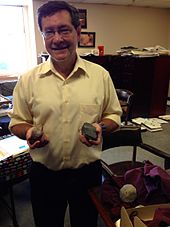
Rick Potts, head of Smithsonian Human Origins projection
The David H. Koch Hall of Human being Origins opened on March 17, 2010, marking the museum'southward 100th anniversary. The hall is named for David H. Koch, who contributed $15 million to the $20.7 million exhibit.[52] [53]
The Hall is "defended to the discovery and understanding of human origins," and occupies 15,000 square feet (i,400 m2) of showroom space. This showroom includes 76 humans skulls, each of a unlike species, eons apart. Each of these species is a human being, signified by the "Homo" genus name. One species that can exist constitute in this gallery is the Homo heidelbergensis, which lived 200,000–700,000 years agone. In addition, there is a female skull from Human floresiensis, a human species that peradventure simply went extinct just 17,000 years agone.[54] The exhibit includes an interactive human family tree that follows six million years of evolution,[55] and a "Irresolute the World" gallery that focuses on issues surrounding climatic change and humans' impact on the earth. The Hall's core concept idea is "What Does It Mean To Be Human", and focuses on milestones of human evolution such every bit walking upright, bigger brains, and symbolic thought. Too covered is the Smithsonian'due south significant research on the geological and climate changes which occurred in Eastward Africa during significant periods of Homo Development. The showroom highlights an actual fossil Neanderthal and replicas created by famed paleoartist, John Gurche.[54] The exhibit has been criticized for downplaying the significance of human-caused global warming.[56] [57]
The showroom also provides a complementary web site, which provides diaries and podcasts straight from related fields of research. The companion volume, What Does It Mean To Exist Human being, was written by Richard (Rick) Potts, the curator, and Christopher Sloan. The exhibit was designed by Reich + Petch.[58]
Dinosaurs/Hall of Paleobiology [edit]

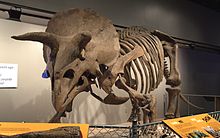
A FossiLab volunteer uses lab equipment to sift through collected sediments for bone particles at the Smithsonian National Museum of Natural History.
The Hall of Dinosaurs has fossilized skeletons and cast models, including a Tyrannosaurus rex cast facing a Triceratops cast. This Triceratops exhibit shows the first accurate dinosaur skeleton in virtual move, achieved through the utilise of scanning and digital technology."[59] [sixty] The collection consists of 46 "consummate and important specimens" of dinosaurs.[61]
In May 2012, billionaire David H. Koch donated $35 million toward the cost of a $45 million upgrade to the 30-twelvemonth-old, 25,000 square feet (2,300 thou2) dinosaur hall. The hall airtight in the spring of 2014 and reopened in 2019.[62]
In June 2013, the Smithsonian obtained a 50-year lease on a T. rex fossil skeleton endemic by the The states Army Corps of Engineers. It is the showtime T. rex skeleton to be displayed at the museum, which until now has only had the cast of a skull. The specimen, known as the "Wankel" or "Devil" rex,[63] was found on Corps-owned land in the Charles M. Russell National Wildlife Refuge in Montana in 1988. It has since been on display at the Museum of the Rockies in Bozeman, Montana (which helped excavate the fossil).[64] The "Wankel king" (whose skeleton is 85 percent complete)[65] was to be unveiled at the Museum of Natural History on National Fossil Mean solar day, October 16, 2013, and was supposed to be on display until the dinosaur hall exhibit closes for renovation in the leap of 2014. The 35-pes (11 thousand) long skeleton will be the centerpiece of the dinosaur hall when it re-opens in 2019.[64] The Museum of the Rockies (which did not own the skeleton only was the repository for information technology) has about a dozen T. rex specimens, including 1 which is eighty percent complete. Only nigh six museums in the United States accept a T. rex skeleton. The Museum of the Rockies is a Smithsonian chapter museum, and had long promised to find a T. king for the Smithsonian to display.[65]
Due to the 2013 federal regime shutdown, the fossil did not get in in Washington, D.C. Smithsonian officials said information technology remained in storage in Montana, and would not arrive at the Smithsonian until belatedly spring 2014. Packed up in 16 crates, the T. rex, named "Nation's T. rex" by the Smithsonian, traveled from the Museum of the Rockies and arrived at the National Museum of Natural History on April fifteen, 2014.[66] The T. rex was displayed in the Male monarch Room, while specialists performed a conservation assessment and the Smithsonian Digitization Program scanned each bone, to create a three-D model for inquiry.[67] The Nation'due south T. rex is the centerpiece of the new fossil hall, which opened in 2019.[68]
Hall of Mammals [edit]
The Behring Hall of Mammals was designed by Reich + Petch. The mammal specimens are presented as works of modern fine art within minimal environmentals. Visitors discover mammal'southward evolutionary adaptions to hugely various contexts, and ultimately observe that they too are mammals.[ citation needed ]
The museum has the largest collection of vertebrate specimens in the globe, nearly twice the size of the next largest mammal collections, including historically important collections from the nineteenth and early on twentieth centuries.[69] Its drove was initiated by C. Hart Merriam and the U.S. Department of Agriculture (afterwards the Section of the Interior), which expanded it in the 1890s-1930s.[70]
Insect Zoo [edit]
The O. Orkin Insect Zoo features live insects and exhibits about insects and entomologists. Dissimilar habitats have been created to bear witness the type of insects that live in unlike environments and how they have adapted to a freshwater pond, house, mangrove swamp, desert, and rain forest. The zoo is sponsored by Orkin, a pest control company.
Sea Hall [edit]
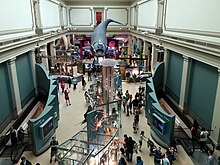
The Sant Body of water Hall opened on September 27, 2008, and is the largest renovation of the museum since it opened in 1910. The hall includes 674 marine specimens and models drawn from the over 80 million specimens in the museum's total drove, the largest in the globe. The hall is named for the Roger Sant family, who donated $fifteen million to endow the new hall and other related programs.
The collection includes: a Due north Atlantic correct whale, a giant Lion'south mane jellyfish model, a 1,500-The states-gallon (5,700 fifty) aquarium, one female behemothic squid displayed in the eye of the hall and a male person displayed off to the side, an developed coelenterate, and a Basilosaurus.[71]
The museum too provides the Smithsonian Ocean Portal, a complementary web site that provides regularly updated, original content from the museum'due south enquiry, collections, and Sant Ocean Hall as well every bit content provided by more than 20 collaborating organizations, including Archive, Census of Marine Life, Consortium for Ocean Leadership, Encyclopedia of Life, Conscript, Monterrey Bay Aquarium, Monterrey Bay Aquarium Research Institute, National Geographic, NOAA, New England Aquarium, Bounding main Conservancy, Oceania, Pew Charitable Trusts, Body of water Web, Save Our Seas, Scrips Establishment of Oceanography, Woods Pigsty Oceanographic Institution, Globe Heritage Marine Programmer.
African Voices [edit]
This exhibit and associated website "examines the diversity, dynamism, and global influence of Africa's peoples and cultures over fourth dimension in the realms of family unit, work, community, and the natural surround."[72]
Collywobbles + Plants: Partners In Development [edit]
Featuring a live butterfly pavilion allows "visitors to detect the many ways in which butterflies and other animals have evolved, adapted, and diversified together with their establish partners over tens of millions of years."[72] The exhibit was designed by Reich + Petch.
Western Cultures Hall [edit]
"This hall explores some examples from various cultures in the western world including northern Iraq, ancient Egypt, Greece and Rome and the recent discovery of the Iceman, a Copper Historic period mummy plant in an Italian glacier."[72] This exhibit closed September 26, 2010.
Korea Gallery [edit]
The Korea Gallery is a special showcase to celebrate Korean traditions and examine its unique influence and complex role in the world today.
The exhibit expresses the continuity of the past by highlighting enduring features of Korean culture that have influence and resonance today.[ citation needed ] The exhibit uses the Smithsonian ceramics collection as well as a rich choice of photographs, ritual objects and traditional Korean carpentry to communicate and connect to both the local Korean community and an international audience. Traditional art forms, such equally ceramics and calligraphy, along with mythological figures, language, large feature photographs and illustrations speak to a range of shared historical memories that connect Koreans at home and away.
Personal stories of modern Koreans, equally told in their own voices, provide a context to talk over some of the many issues that face the divided country today. Korea's incredible transformation from 'The Hermit Kingdom' to a world ability is traced through its bear upon on the arts, the economic system and popular civilization.[ citation needed ] The exhibit was designed by Reich + Petch. This exhibit closed in 2017.
Teleology: Hall of Bones [edit]
This exhibit displays a "variety of vertebrate skeletons grouped by their evolutionary relationships."[72]
Q?rius [edit]
Opened since 2013, this showroom is the museum's interactive and educational area. Using microscopes and impact screens, the surface area hosts various interactive activities and puzzles visitors tin experience and contains a "collection zone" that houses over 6000 dissimilar specimens and artifacts visitors are able personally handle. The expanse likewise hosts various events such as allowing visitors to meet and discuss with Smithsonian scientists and hosting schoolhouse groups.[73]
Other [edit]
The Discovery Room, a family- and student-friendly hands-on activity room on the beginning floor.[74]
In the lower level, there is a bird exhibit, Urban Bird Habitat Garden, with all the migratory and native birds to Washington, D.C.[75]
The Global Volcanism Program is housed in the section of Mineral Sciences.
The museum frequently hosts sleepovers through the Smithsonian Associates for children ages viii–12.[76]
Gallery [edit]
-
Rotunda during the mean solar day
-
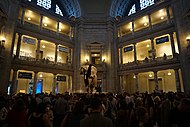
Rotunda at night
-

Old Hall of Dinosaurs
-
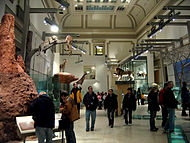
Hall of Mammals
-

Hall of Mammals
-

Hall of Ocean Life
-

In popular civilisation [edit]
- The exteriors of the Museum were used as a model for the "Leyendecker Museum" in the Sierra On-Line 1992 adventure game The Dagger of Amon Ra.
- In the 2008 video game Fallout 3, a derelict showroom at the museum serves as the entrance to Underworld, a civilization established by ghouls.
- In the 2008 film Get Smart, the fictional spy organisation CONTROL is located underneath the National Museum of Natural History.
- The giant squid from the National Museum of Natural History inspired the octopus that comes to life in 20th Century Fox's 2009 film Night at the Museum: Battle of the Smithsonian.[77]
- A version of the museum is featured every bit a partially-explorable location and one of the few quarantined areas in the 2019 tertiary-person shooter The Division two.
- A drawing of the museum was featured in an episode of the animated comedy Inside Task in 2021.
See besides [edit]
- John Varden
- Listing of nigh-visited museums in the United States
References [edit]
- ^ TEA-AECOM Museum Index 2020, published September 2021
- ^ "The World's nearly popular museums", CNN.com, 22 June 2017.
- ^ a b c "Enquiry & Collections". National Museum of Natural History. Archived from the original on xv April 2012. Retrieved 12 April 2012.
- ^ "Collections at the National Museum of Natural History". National Museum of Natural History. Archived from the original on vi Feb 2019. Retrieved 19 February 2020.
- ^ Johnson, Kirk (ii March 2019). "Smithsonian Museum and Zoo records the natural earth as information technology collides with homo civilisation" (Interview). Interviewed by Robyn Williams. Australian Dissemination Corporation. Archived from the original on 26 February 2020. Retrieved 26 February 2020.
- ^ D'Angelis, p. 35.
- ^ Evelyn, Dickson, and Ackerman, p. 107.
- ^ "Plans for Museum Edifice." Washington Mail service. July 6, 1902.
- ^ a b "New Building for Museum." Washington Post. January thirty, 1903.
- ^ "Site of New National Museum." Washington Mail service. March 7, 1903.
- ^ a b "New Museum Plans." Washington Mail. April 13, 1903.
- ^ "Museum Edifice Design." Washington Mail service. May 24, 1903.
- ^ "This Day in Smithsonian History - March". Siarchives.si.edu. Archived from the original on 2010-06-08. Retrieved 2010-04-xviii .
- ^ "Museum History". National Museum of Natural History. 2008. Archived from the original on 2009-07-26. Retrieved 2009-11-fifteen .
- ^ Bache, Rene. "America'south $three,500,000 National Museum, Just Completed, Most Remarkable Structure of Its Kind in the World." Washington Post. March 6, 1910.
- ^ a b Trescott, Jacqueline. "Smithsonian Taps Biologist For Natural History Museum." Washington Post. January 30, 2003.
- ^ "Smithsonian Selects Friday for Natural History Post." Orlando Sentinel. March 21, 1996.
- ^ a b Olson, Elizabeth. "A Biologist Will Pb Smithsonian Museum." New York Times. January thirty, 2003.
- ^ "Washington: New Museum Director." New York Times. July 26, 2001.
- ^ Wiltz, Teresa. "Smithsonian Losing a Sixth Key Managing director." Washington Post. April four, 2002.
- ^ "Interim Chief Named At Natural History." Washington Mail. June 6, 2002.
- ^ a b "Biologist Named to Head Smithsonian Natural History Museum." Associated Printing. January 29, 2003.
- ^ Epstein, Edward. "East Bay Developer Pumps Millions Into Smithsonian Project." San Francisco Chronicle. November xv, 2003.
- ^ Trescott, Jacqueline. "Museum to Get $60 Million Showroom." Washington Post. September 16, 2004.
- ^ "Tiffany Makes $1.1 One thousand thousand Gift to Smithsonian Museum." Associated Press. June 7, 2006.
- ^ Zongker, Brett. "Smithsonian's Top Official Resigns." Associated Press. March 26, 2007.
- ^ Pogrebin, Robin. "Smithsonian Scrambles to Regain Its Basis." New York Times. Apr four, 2007.
- ^ "Acting Director Named at Smithsonian'southward Natural History Museum." Associated Printing. March thirty, 2007.
- ^ a b c d e f g h Grimaldi, James Five. and Trescott, Jacqueline. "Scientists Fault Climate Exhibit Changes." Washington Post. November 16, 2007.
- ^ Zongker, Brett. "Smithsonian Toned Downwardly Exhibit on Arctic." Associated Press. May 21, 2007.
- ^ Pogrebin, Robin. "Souvenir to Smithsonian Is Rescinded." New York Times. November 17, 2007.
- ^ "Head of Smithsonian'southward Natural History Museum Returning to OU." Associated Press. January 23, 2008.
- ^ "GIT President to Head Smithsonian." United Printing International. March 15, 2008.
- ^ "Couple Gives $15M for Smithsonian Bounding main Hall." Associated Press. June 26, 2008.
- ^ Schmid, Randolph E. "Hope Diamond to Get New Setting for Anniversary." Associated Press. August 19, 2009.
- ^ Zongker, Brett. "Smithsonian Opens $21M Human Evolution Hall." Associated Press. March 17, 2010; Brotherton, Elizabeth. "Natural History Details Origin of Our Species." Roll Call. March 22, 2010.
- ^ Zongker, Brett. "Head of Smithsonian Natural History Museum Resigns." Associated Press. January 23, 2012.
- ^ Trescott, Jacqueline. "Natural History Museum Gets $35 Million Gift." Washington Post. May iv, 2012; "Koch Gives Smithsonian $35M for New Dinosaur Hall." Associated Printing. May 3, 2012.
- ^ Trescott, Jaqcqueline. "Sants Requite $10 Million to Natural History Museum." Washington Post. June 27, 2012.
- ^ Parker, Lonnae O'Neal. "Smithsonian Names New Director of Natural History Museum." Washington Post. July 26, 2012; Zongker, Brett. "Smithsonian Picks Paleontologist to Lead DC Museum." Associated Printing. July 26, 2012.
- ^ Kamen, Al. "Come across the Smithsonian'south Fossil Guy." Washington Mail. August twenty, 2013. Archived July 19, 2017, at the Wayback Machine Accessed 2013-08-20.
- ^ "Collections at the National Museum of Natural History | Smithsonian National Museum of Natural History". naturalhistory.si.edu . Retrieved 2022-04-13 .
- ^ "NMNH Fact Sheet". Smithsonian Establishment. Archived from the original on 19 Oct 2019. Retrieved 26 February 2020.
- ^ a b c d "About the Museum". National Museum of Natural History. Archived from the original on 15 August 2012. Retrieved 31 July 2012.
- ^ "Vertebrate Zoology: Division of Amphibians & Reptiles". National Museum of Natural History. 2008. Archived from the original on 2008-x-21. Retrieved 2008-09-17 .
- ^ "Division of Amphibians & Reptiles". National Museum of Natural History. 2020. Archived from the original on 16 December 2019. Retrieved 26 Feb 2020.
- ^ "Loan Plan". National Museum of Natural History. Archived from the original on 6 Feb 2019. Retrieved 26 February 2020.
- ^ "Museum Support Center Library". Smithsonian Libraries. Archived from the original on two July 2012. Retrieved 2 August 2012.
- ^ Juliet Eilperin. Trump has long vowed to slash regime Archived 2018-03-11 at the Wayback Machine. Washington Mail service. 26 Feb 2018
- ^ a b Hevesi, Dennis (2008-04-06). "George Switzer, 92, Dies; Started a Gem Treasury". New York Times. Archived from the original on 2013-12-20. Retrieved 2008-04-09 .
- ^ "Department of Mineral Sciences Collections Overview". Smithsonian Institution. Archived from the original on iii Baronial 2019. Retrieved 26 February 2020.
- ^ Klein, Julia K. (May xi, 2010). "Our Species Rediscovers Its Cousin". Wall Street Journal.
- ^ "Smithsonian Opens Human being Development Hall". CBS News. March 17, 2010. Archived from the original on 22 October 2014. Retrieved 17 October 2014.
- ^ a b Rothstein, Edward (March eighteen, 2010). "Searching the Bones of Our Shared By". Archived from the original on 27 October 2014. Retrieved 17 October 2014.
- ^ O'Sullivan, Michael (March 19, 2010). "Smithsonian'south Natural History Museum opens its Hall of Human Origins". The Washington Post. Archived from the original on 25 Oct 2014. Retrieved 17 October 2014.
- ^ "Polluter-Funded Evolution & Climate Showroom at the Smithsonian". National Wildlife Federation. 2010-09-ten. Archived from the original on 2014-05-06.
- ^ Mayer, Jane (August xxx, 2010). "Covert Operations: The billionaire brothers who are waging a state of war against Obama". The New Yorker. Archived from the original on October 7, 2012. Retrieved March xx, 2015.
- ^ "New Exhibition Hall Devoted to Human Origins Opens at National Museum of Natural History". National Museum of Natural History. March 2010. Retrieved 2010-03-16 . [ dead link ]
- ^ "New and Improved". National Geographic. December ane, 2000. Retrieved 2008-09-17 . [ dead link ]
- ^ "Dinosaur Hall". National Museum of Natural History. 2008. Archived from the original on 2008-09-13. Retrieved 2008-09-17 .
- ^ "Dinosaur Collections". National Museum of Natural History. 2008. Archived from the original on 2008-09-13. Retrieved 2008-09-17 .
- ^ Trescott, Jacqueline. "David Koch Donates $35 1000000 to National Museum of Natural History for Dinosaur Hall." Washington Post. May 3, 2012. Archived July xix, 2017, at the Wayback Machine Accessed 2012-05-28.
- ^ The specimen was establish in sediments known as the Hell Creek Formation, hence the name "Devil king".
- ^ a b du Lac, J. Liberty "Tyrannosaurus male monarch Gets Long-Term Lease at Smithsonian'due south Natural History Museum." Washington Postal service. June 27, 2013. Archived July 20, 2017, at the Wayback Auto Accessed 2013-06-28.
- ^ a b Schontzler, Gail. "Montana T. rex Heading to Smithsonian." Bozeman Daily Chronicle. June 28, 2013. Archived July 7, 2013, at the Wayback Machine Accessed 2013-06-28.
- ^ "The Nation'due south T. Male monarch Invades the Smithsonian". nationalgeographic.com. 17 April 2014. Archived from the original on 1 July 2017. Retrieved 2 May 2018.
- ^ "How to 3-D print a dinosaur". PBS NewsHour. 2014-06-25. Archived from the original on 15 July 2017. Retrieved ii May 2018.
- ^ Lac, J. Freedom du (xv April 2014). "T. king fossils arrive at Smithsonian's National Museum of Natural History". Archived from the original on nineteen July 2017. Retrieved two May 2018 – via www.washingtonpost.com.
- ^ "Department of Vertebrate Zoology". National Museum of Natural History. 2008. Archived from the original on 2008-09-17. Retrieved 2008-09-17 .
- ^ "Vertebrate Zoology: Sectionalisation of Mammals". National Museum of Natural History. 2008. Archived from the original on 2008-08-02. Retrieved 2008-09-17 .
- ^ "The New Sant Sea Hall Opens Sept 27. at the Smithsonian'due south National Museum of Natural History" (PDF). National Museum of Natural History. September 24, 2008. Archived from the original (PDF) on April 9, 2009. Retrieved 2009-07-28 .
- ^ a b c d "Electric current Exhibitions". National Museum of Natural History. Archived from the original on 2009-07-27.
- ^ "Q?rius, The Coralyn W. Whitney Science Education Eye". si.edu. 9 September 2015. Archived from the original on 12 September 2017. Retrieved 2 May 2018.
- ^ "National Museum of Natural History - Smithsonian Establishment". Washington Postal service. 2008. Retrieved 2008-09-17 .
- ^ "Urban Bird Habitat Garden". Exhibitions. Smithsonian Institution. Archived from the original on 24 October 2012. Retrieved 24 Oct 2012.
- ^ "Smithsonian Sleepovers". Smithsonian Institution. Archived from the original on 16 July 2016. Retrieved 10 July 2016.
- ^ ""Night at the Museum: Battle of the Smithsonian" Treasure Map". Smithsonian Institution. Archived from the original on 2009-05-17.
Bibliography [edit]
- D'Angelis, Gina. It Happened in Washington, D.C. Guilford, Conn.: TwoDot, 2004.
- Evelyn, Dougas E.; Dickson, Paul; and Ackerman, South.J. On This Spot: Pinpointing the Past in Washington, D.C. Sterling, Va.: Capital Books, 2008.
- Redman, Samuel J. Os Rooms: From Scientific Racism to Human Prehistory in Museums. Cambridge: Harvard University Press. 2016.
External links [edit]
-
 Geographic data related to National Museum of Natural History at OpenStreetMap
Geographic data related to National Museum of Natural History at OpenStreetMap - National Museum of Natural History official website
- A Cursory History of the Museum - from the NMNH website
- National Museum of Natural History - National Gem and Mineral Drove
- Research collections of the National Museum of Natural History
- Finding Aid to the Records of the Department of Anthropology, United States National Museum-National Museum of Natural History, Manuscript and Pamphlet File, National Anthropological Archives, Smithsonian Institution
- Smithsonian National Museum of Natural History at Google Cultural Constitute
weingartnerfrivinse.blogspot.com
Source: https://en.wikipedia.org/wiki/National_Museum_of_Natural_History

0 Response to "National Museum of Women of Modern Arts Washington Dc"
Postar um comentário